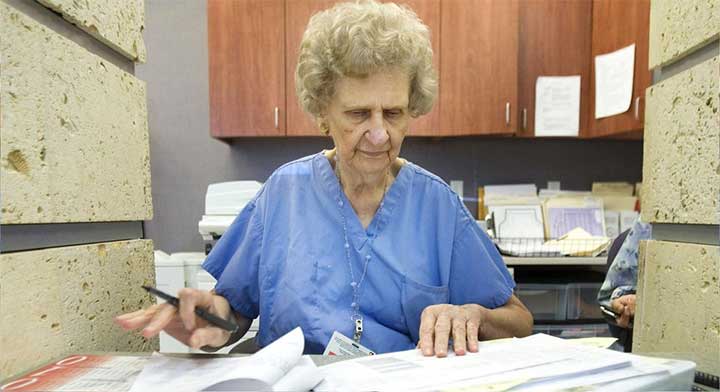Where’s the support for work-injured nurses?
Congratulations on your premier issue. The article “Cultivating personal courage” is a wonderful encouragement for working nurses. How-ever, it’s missing a voice for nurses who are victims of the healthcare system. Many nurses who become disabled due to manual patient lifting are fired. These nurses are isolated, on the outside looking in, with no cadre of courageous fellow nurses working to help them remain with their employer. They’re expected to just go away and start over at the bottom in some other field.
Disabled work-injured nurses are cast out by healthcare employers and are forgotten—shunned, essentially—by the nursing community. Yet the industry is looking for ways to retain older nurses or recruit retired nurses. Surely these nurses wouldn’t be expected to lift up to thousands of pounds every shift! The industry is also discussing accommodations that would allow disabled people to enter the profession. But there’s a deafening silence on assisting work-injured nurses to stay on the job or return to nursing (if possible). Why doesn’t the nursing community support these nurses and protest their outrageous exploitation?
Thousands of work-injured nurses have no voice or assistance. This is one reason I founded Work Injured Nurses’ Group USA (www.wingusa.org). My hope is that those with power and influence will come to the aid of nurses who’ve been fired and forgotten because they can no longer lift patients.
Anne Hudson, BSN, RN
Coos Bay, OR
Refreshing, upbeat, and up-to-date
American Nurse Today is off to a good start. It’s refreshing and upbeat. The content is up-to-date and the page layout is open and easily readable. I especially liked “How do you look?” in the October issue.
I hope you’ll publish more articles on the topic of making nursing a profession rather than just a career path. We especially need to focus on determining the entry-level educational requirement for nurses. Physical therapists are moving toward a 5-year program; why shouldn’t the nursing profession?
Delia Skrainski
Wilton, CT
More nursing memories
Thanks to the readers who sent their nursing memories in response to “Look how far we’ve come: Nursing through the years” in the October issue. We think you’ll get a kick from the following memories (all from Baby boomers).
In my ADN program (1979-1981), we were warned that the BSN would be the minimum entry level for RNs by 1984. Back then, nursing diagnoses were the new thing, and we had to attend training conferences to learn how to use them. Medicare diagnostic-related groups (DRGs) didn’t exist; patients were admitted on the flimsiest diagnoses and stayed forever (it seemed), because Medicare paid. I also recall some patients being admitted for “tests” or “organic brain syndrome” for the weekend so their families could go out of town!
We’d never heard of MRSA or a 12-hour shift. We needed a physician’s order to wash a patient’s hair, cut his fingernails, and do pretty much anything else. Patient gowns didn’t have snaps. Patients smoked in their rooms. Private rooms didn’t exist, so a smoker tied up a room or two smokers roomed together.
Sharps containers were available only at the medication preparation area. The Rule of Six was the newfangled way to calculate drug infusions. We had to calculate I.V. drip rates, and I.V. lines had Dialaflows to make them more “accurate.” The few I.V. pumps available were reserved for pediatric patients and drug infusions. Tonsillectomy patients got three preoperative I.M. medications that couldn’t be given together—AquaMEPHYTON, Valium, and Demerol. Nembutal and Seconal were the sleeping pills of choice, and Inderal was the only beta blocker on the market. We administered all pain medications I.M.
Most surgeries—including cataract surgery—were done on an inpatient basis. For many types of surgeries, patients were admitted the night before (if not earlier). Also, patients with deep-vein thrombosis were hospitalized to receive subcutaneous heparin every 4 hours.
Laparoscopic surgery and patient-controlled analgesia didn’t exist. IPPB treatments were given to prevent or treat atelectasis. Mechanically ventilated patients received paralytics while intubated. We routinely performed saline lavages before suctioning; we didn’t have in-line suction catheters. Pulse oximeters were new—the hospital had just one, and it was kept locked in the respiratory therapy department. ACLS was dreaded; we cried because the Megacode was so awful. We had to learn the Henderson-Hasselbach equation for ACLS. The routine ACLS protocol included sodium bicarbonate and calcium chloride.
We had mandatory inservice programs on “good body mechanics” which, if practiced correctly, would supposedly save us from back injury. And we wore white uniforms.
Kristine W. Davis, BSN, CCRN
Cedar City, UT
I remember when EKGs were run in one long strip and you had to mark them to tell which lead you were looking at: one long, two longs, three longs, one long and one short, one long and two shorts, one long and three shorts, one short, two shorts, three shorts, four shorts, five shorts, and six shorts! The ER had one monitor with a round green oscilloscope, and you couldn’t run strips or defibrillate!
Pills were stored in jars inside a metal cabinet with glass doors, and the cabinet was seldom locked. Rotating tourniquets were used for patients with pulmonary edema. Sugar tong splints were used for patients with humerus fractures.
The county dispatcher had radio check every Tuesday evening: “Read you 5-5. How me?” Rural ambulances had no means of communication and just showed up at the door.
Paula M. McNulty, BSN, MBA, RN
Altoona, PA
We used to sharpen needles and put glass syringes in the autoclave. I remember when the “mini drop” for I.V. infusion was invented, when we had no apnea meters for babies, and when babies weighing 5 to 6 lb were considered preemies. Nursing care plans had five to seven columns, with the “scientific reason.”
Terry Walsh Gottlieb, EdD, RN-BC
New York, NY
Editor’s note: In the October issue, the diagram on page 12 should have had the following credit line:
© 2006 ICON.
















